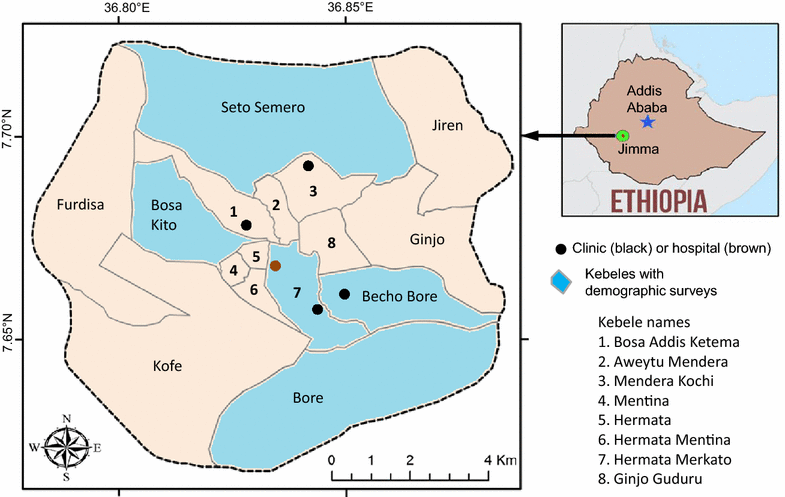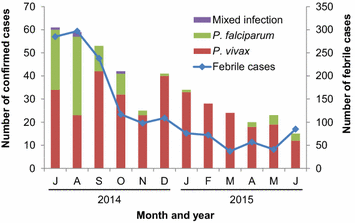Analysis of asymptomatic and clinical malaria in urban and suburban settings of southwestern Ethiopia in the context of sustaining malaria control and approaching elimination
- PMID: 27129785
- PMCID: PMC4851815
- DOI: 10.1186/s12936-016-1298-2
Analysis of asymptomatic and clinical malaria in urban and suburban settings of southwestern Ethiopia in the context of sustaining malaria control and approaching elimination
Abstract
Background: Malaria intervention in Ethiopia has been strengthened significantly in the past decade. The Ethiopian government recently stratified the country based upon annual parasite incidence into malaria free, low, moderate and high transmission strata. Districts with low transmission were targeted for indigenous transmission elimination. Surveillance on malaria disease incidence is needed for planning control and elimination efforts.
Methods: Clinical malaria was monitored prospectively in health facilities in Jimma town, Oromia Region, southwestern Ethiopia from July 2014 to June 2015. Seasonal cross-sectional parasite prevalence surveys in local communities were conducted in 2014 and 2015 in eight kebeles. Case report forms were administered to obtain sociodemographic and epidemiological information from patients.
Results: A total of 1434 suspected malaria cases were examined from the health facilities and 428 confirmed malaria cases were found. Among them, 327 (76.4 %) cases were Plasmodium vivax, 97 (22.7 %) were Plasmodium falciparum, and 4 (0.9 %) were mixed infection of P. vivax and P. falciparum. The annual malaria incidence rate was 1.7 cases per 1000 people at risk. Parasite prevalence in the community was less than 3 %. Household ownership of insecticide-treated nets (ITNs) was 47.3 % (1173/2479) and ITN usage was 37.9 %. All ITNs were long-lasting insecticidal nets, and repellent use was not found in the study area. Being male and traveling were the significant risk factors for P. falciparum malaria. For P. vivax malaria, risk factors included occupation and history of malaria illness during the preceding 30 days.
Conclusion: Epidemiological evidence suggested low clinical malaria incidence and prevalence in Jimma town. More aggressive measures may be needed to further suppress vivax transmission. Strategies should be planned targeting sustained control and elimination.
Keywords: Ethiopia; Incidence; Malaria; Prevalence; Risk factor; Urban area.
Figures



Similar articles
-
Prevalence of asymptomatic malaria infection and associated risk factors in Mizan-Aman town, Ethiopia: community-based cross-sectional study.Malar J. 2025 Feb 12;24(1):41. doi: 10.1186/s12936-024-05210-8. Malar J. 2025. PMID: 39939966 Free PMC article.
-
Microscopic and molecular evidence of the presence of asymptomatic Plasmodium falciparum and Plasmodium vivax infections in an area with low, seasonal and unstable malaria transmission in Ethiopia.BMC Infect Dis. 2015 Aug 5;15:310. doi: 10.1186/s12879-015-1070-1. BMC Infect Dis. 2015. PMID: 26242405 Free PMC article.
-
Schoolchildren with asymptomatic malaria are potential hotspot for malaria reservoir in Ethiopia: implications for malaria control and elimination efforts.Malar J. 2023 Oct 16;22(1):311. doi: 10.1186/s12936-023-04736-7. Malar J. 2023. PMID: 37845680 Free PMC article.
-
Malaria epidemiology and interventions in Ethiopia from 2001 to 2016.Infect Dis Poverty. 2018 Nov 5;7(1):103. doi: 10.1186/s40249-018-0487-3. Infect Dis Poverty. 2018. PMID: 30392470 Free PMC article. Review.
-
Ready for malaria elimination: zero indigenous case reported in the People's Republic of China.Malar J. 2018 Aug 29;17(1):315. doi: 10.1186/s12936-018-2444-9. Malar J. 2018. PMID: 30157876 Free PMC article. Review.
Cited by
-
Urban malaria and its determinants in Eastern Ethiopia: the role of Anopheles stephensi and urbanization.Malar J. 2024 Oct 9;23(1):303. doi: 10.1186/s12936-024-05126-3. Malar J. 2024. PMID: 39385192 Free PMC article.
-
Asymptomatic Plasmodium Infection and Associated Factors in Selected Districts of the Kaffa Zone, Southwest Ethiopia: A Cross-Sectional Study.J Trop Med. 2023 Apr 13;2023:4144834. doi: 10.1155/2023/4144834. eCollection 2023. J Trop Med. 2023. PMID: 37091858 Free PMC article.
-
The epidemiology and detectability of asymptomatic plasmodium vivax and plasmodium falciparum infections in low, moderate and high transmission settings in Ethiopia.Malar J. 2021 Jan 22;20(1):59. doi: 10.1186/s12936-021-03587-4. Malar J. 2021. PMID: 33482841 Free PMC article.
-
Population travel increases the risk of Plasmodium falciparum infection in the highland population of Gardula Zone, South Ethiopia: A longitudinal study.PLoS One. 2024 Dec 20;19(12):e0315900. doi: 10.1371/journal.pone.0315900. eCollection 2024. PLoS One. 2024. PMID: 39705289 Free PMC article.
-
Prevalence of asymptomatic malaria infection and associated risk factors in Mizan-Aman town, Ethiopia: community-based cross-sectional study.Malar J. 2025 Feb 12;24(1):41. doi: 10.1186/s12936-024-05210-8. Malar J. 2025. PMID: 39939966 Free PMC article.
References
-
- WHO . World malaria report 2015. Geneva: World Health Organization; 2015.
-
- Federal Ministry of Health of Ethiopia . National malaria guidelines. Addis Ababa: Third Edition; 2012.
-
- Federal Ministry of Health of Ethiopia. Ethiopia National Malaria Indicator Survey 2011 Technical Summary. Addis Ababa; 2012.
-
- Federal Ministry of Health of Ethiopia. National strategic plan for malaria prevention, control and elimination in Ethiopia, 2011–2015 (2003/2004 –2007/2008 E.C.). Addis Ababa; 2010.
-
- WHO . World malaria report 2014. Geneva: World Health Organization; 2014.
Publication types
MeSH terms
Grants and funding
LinkOut - more resources
Full Text Sources
Other Literature Sources
Miscellaneous

